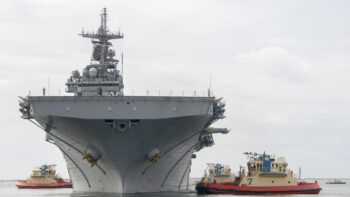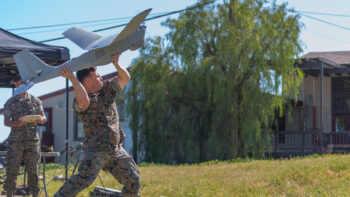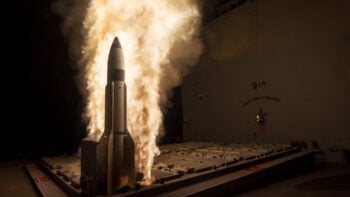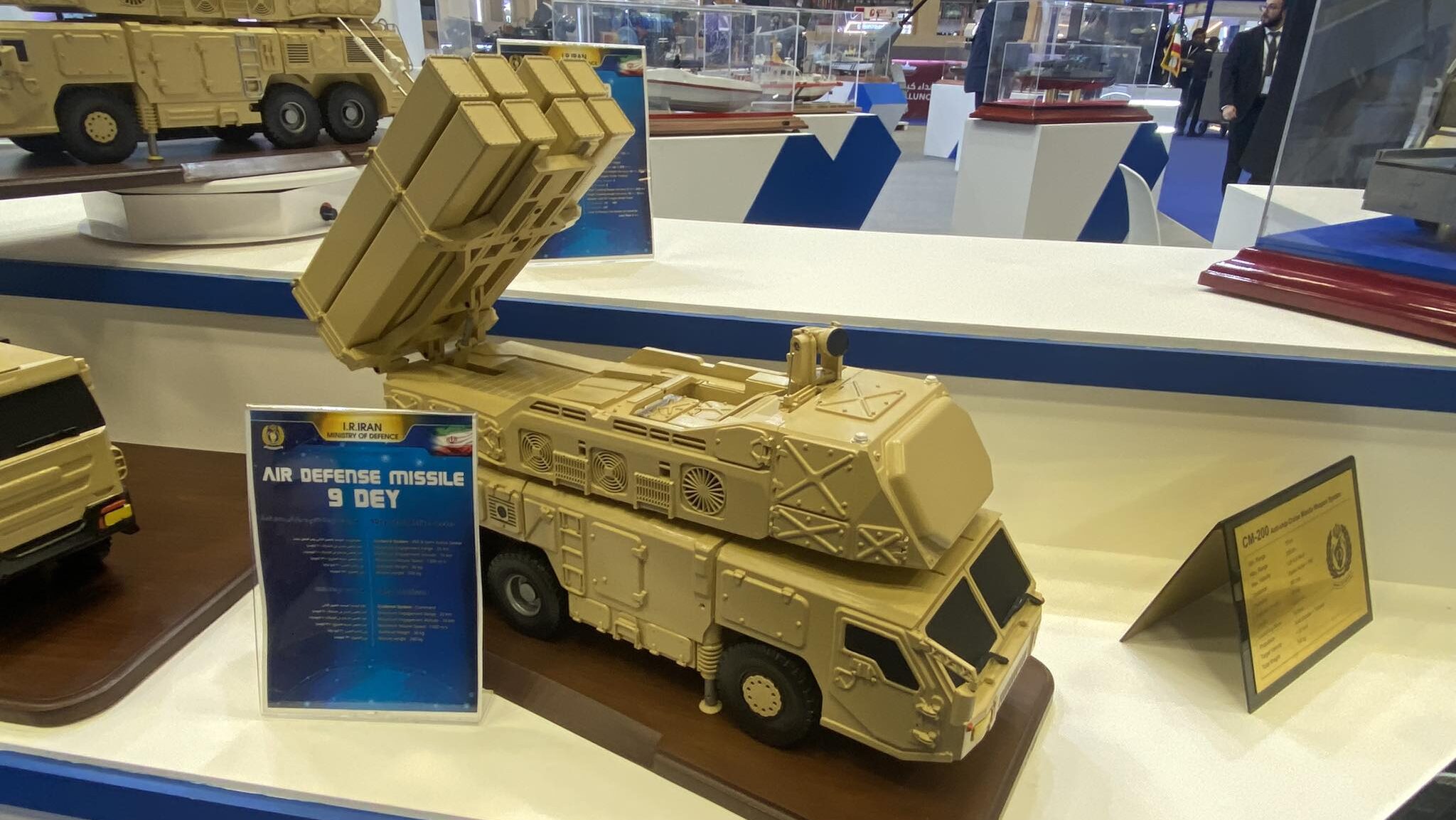
Iranian Air Defense system featuring 9 Dey missile displayed at Dimdex 2024 defense expo in Qatar (Agnes Helou / Breaking Defense)
BEIRUT — In the early morning hours today, multiple explosions reportedly took place in central Iran, the result of Israeli munitions striking near Isfahan or, possibly, the result of Iran’s air defense systems knocking some threats out of the sky.
As details slowly emerged, it remained unclear what Jerusalem supposedly used for the attack — some reports indicated missiles, while Iranian media made references to small drones. So far there have been no reports of casualties, and though Isfahan is home to some Iranian nuclear facilities, the International Atomic Energy Agency said those had not been damaged.
Tehran has played down the attack as small scale, compared to the approximately 350 missiles and drones it launched at Israel on April 13. In that case Israel’s air defense systems, with significant help from the US, UK, France and even Jordan, managed to knock out a vast majority of the threats before they could do any damage.
Though Iranian officials claimed its air defenses were successful in today’s incident as well, it remains to be seen exactly how well those systems did against the much smaller Israeli sortie. Either way, air defense has been an area of increasingly public focus for Tehran in recent years, going as far as to show off its systems at an international defense conference in the Middle East.
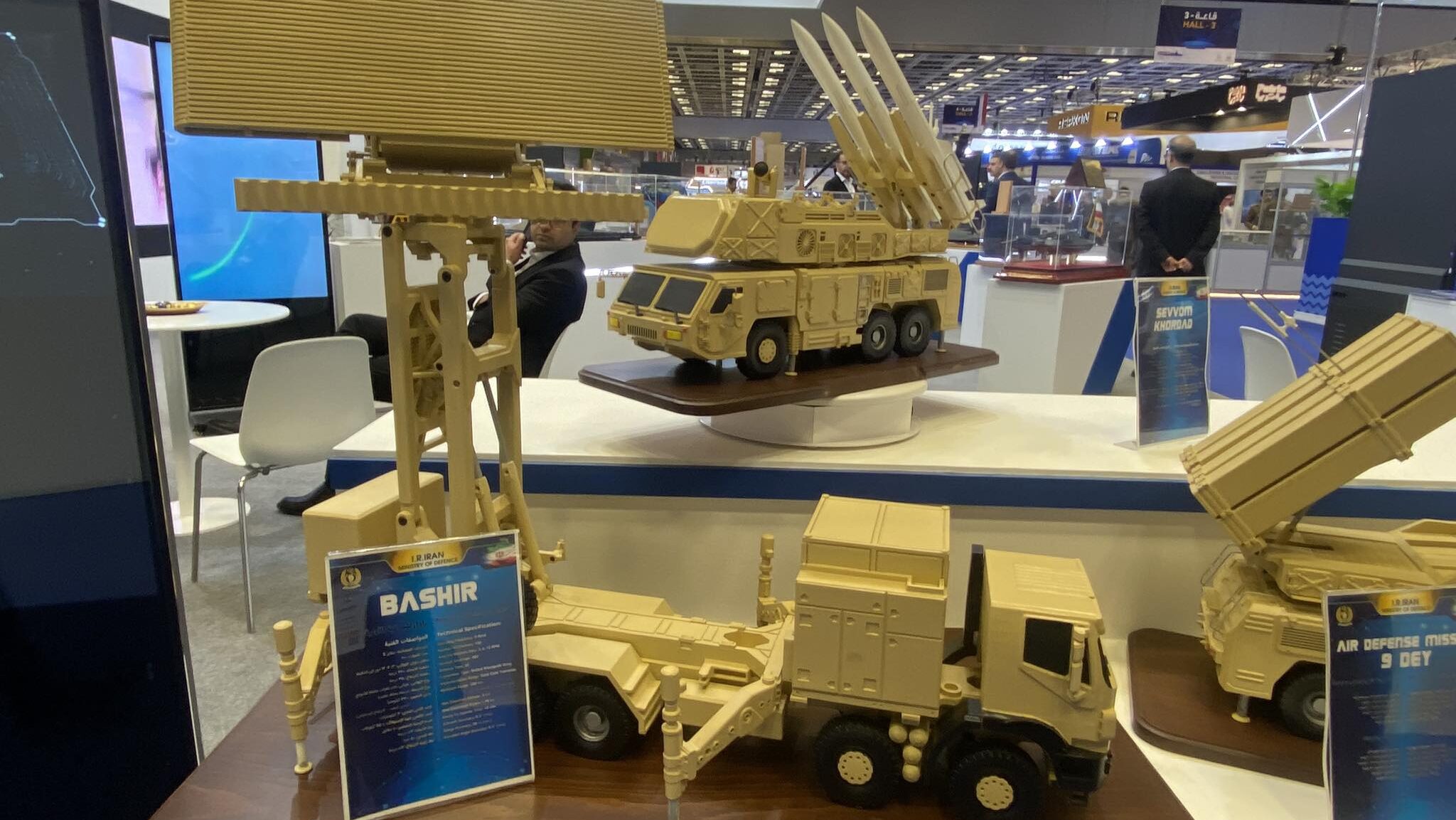
Iranian air defense radar Bashir model displayed at Dimdex 2024 in Qatar (Agnes Helou/ Breaking Defense)
Here’s a look at the systems Iran is believed to operate, based on information available at the shows, published analysis from the US Defense Intelligence Agency and media reporting. While it is unclear how many of any given system Iran currently has active, the takeaway is clear: Tehran has made the creation of a multilayered air defense network a priority.
Different Systems At Different Ranges
The Islamic Republic employs a number of air defense systems for short-, medium- and long-range, including legacy systems from the US, Russia and China. They’re operated by the regular armed forces’ air defense and in parallel with the air defense force of Iran’s Revolutionary Guard.
“Iran operates a diverse array of SAM and radar systems intended to defend critical sites from attack by a technologically superior air force,” the DIA said in a 2019 report [PDF].
Long Range: Last month at the DIMDEX 2024 defense expo in Qatar, Iran marketed a number of air defense systems, including a first ever showing of its long-range Air Defense-200, or AD-200, system outside its own borders, complete with informational brochures.
AD-200 is a “high range and altitude surface to air defense system […] able to engage with 6 targets [using] 12 missiles simultaneously. The system is designed for interception of advanced tactical and strategic aircraft, UAVs, early warning aircraft and helicopters,” according to a booklet offered to Breaking Defense at the show.
Information provided says the system has a minimum range of five kilometers and a maximum range of 200 kilometers, can intercept targets from 200 meters to 27 kilometers high, and can use an inertial guidance system and update via data link to semi-active active radar homing.
There’s also the AD-150, which supposedly has a 120 kilometer maximum range and 27 kilometer maximum altitude reach.
Iran has two Russian-made systems: the SA-5 Gammon (S-200) with 300 kilometer maximum range, and the more advanced SA-20c Gargolye (S-300 PMU2) with 400 kilometer max range that it received in 2016. (The Washington Post reported Iran has been interested in purchasing Russia’s cutting edge S-400 system, though it’s unclear if any deal has been made.)
The SA-20c, the DIA said, “is the most capable component of [Iran’s] integrated air defense system (IADS)” and Tehran is “most likely to use the SA-20c to protect its most critical infrastructure, such as its nuclear sites and Tehran,” the DIA report said. The DIA report says both the SA-20c and the SA-5 are housed at Isfahan.
Iran has also produced its own air defense systems, including the long-range Bavar-373, which an Iranian official reportedly claimed has an extended radar range of 450 kilometers. Lastly, the DIA said Iran uses a Sayyad-3, the longest-reaching air defense system in its Sayyad family of systems.
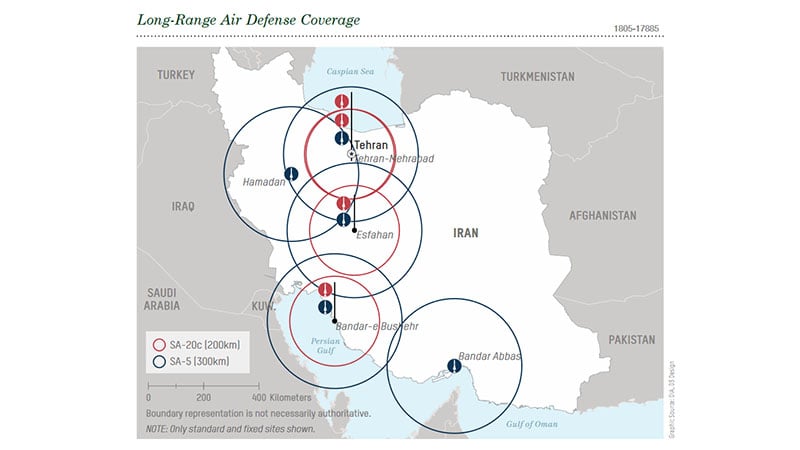
A Defense Intelligence Agency map from a 2019 report on Iran’s long-range air defenses. (DIA Iran Power Report)
Medium Range: For air defenses at a medium range, the brochures at DIMDEX advertised the AD-40 and AD-75 systems. They have ranges of 40 and 75 kilometers, respectively. The documentation says the AD-40 can engage low-speed targets, presumably like drones, while the AD-75 is meant to engage several targets at once.
At the show Iran also displayed a model of its Sevvom Khrodad or Third of Khordad medium-range air defense system, bragging that it was the system that downed an American MQ-4C Triton in 2019. Sevvom Khordad is described by its producer as a “phased array radar, medium height, mobile surface-to-air missile” and is designed “to detect, track and destroy jammers with Taer 2 missiles during electronic warfare.” Its anti-cruise missile, dubbed 9 Dey, has a target attacking range of 20 kilometers and effective altitude of 10 kilometers.
The medium-range category features a legacy US system, the I-HAWK, which was first used by the US Army in 1959; the DIA said has been upgraded and is now known as the Mersad. Other medium-range systems include the domestically produced Raad, Talash, Sayyad-1 and Sayyad-2, according to the DIA.

Booklets advertising Iranian missile capabilities, available for the public at DIMDEX 2024. (Agnes Helou / Breaking Defense)
Short Range: Up close, Iran has a few systems to draw from. At DIMDEX the final member of the AD family was listed in the brochures: AD-08, a short-range system with a max range of eight kilometers that’s designed to engage four targets at a time. It’s meant to go up against UAVs, helicopters and low-flying targets.
The DIA report also lists the SA-15 Gauntlet (Tor M1) and the Rapier as systems in Iran’s inventory.
So it is clear Iran has a multi-layered air defense array, even if its a hodgepodge of systems. As more information comes to light about the events overnight in Isfahan, it may become clearer how well that system did when faced with a rare strike all the way from Israel.
Or, perhaps more worrying for Tehran, how it did if the attack was launched much closer to home. After all, if only small drones were used, that means the attack likely originated from Israeli assets within Iran’s borders.
As Kirsten Fontenrose, a nonresident fellow with the Scowcroft Middle East Security Initiative, wrote, “This makes a much larger point about Israeli reach than flying them in from the outside would and should unsettle regime leadership. Israel’s message to Tehran? ‘The call is coming from inside the house.'”
Chris Calio takes helm of RTX as new chief executive
Calio has overseen the reorganization of RTX into three business units, and has said the company will further de-emphasize its role as a space prime contractor.





















